________________
-
2 -
discuss its geographic extension and possible origin. To begin with, it strikes us that the construction in question, or part of it, is more frequent in Middle Indo-Aryan languages than in old Indian.
From Coomaraswamy's papers it is clear that the meaning of some architectural terms in a certain context is difficult to define, e.g. as regards kūţa and kaņņikā which are both equally roof-plates to which the curved rafters converge in apsidal form
Kūțâgāra, sīha-panjara, hammiya and canda-sālā all pass for separate spaces in a large building each with a roof of its own. Kuţâgāra, however, also occurs as a kind of roof ornament or pinnacle, whereas Coomaraswamy elsewhere expresses the opinion that siha-panjara would really be a 'windowed bay.' The whole terminology of sālā he considers similarly difficult. In definin things from textual sources one has to bear in mind that one largely depends on commentaries written after all by monks.
At different places in his articles, sometimes adding "all references and representations considered" Coomaraswamy has defined kuţâgara in more than one way, e.g. in JAOS in 1928 'a house with a finial (or finials)' or 'an honourable building' whereas in Eastern Art in 1931 he states that "the term kuţâgara especially when combined with -salā may sometimes mean an entire building with a peaked roof, the 'gabled mansion of Pali translators, but I am not convinced of this; and usually the kūţâgara is a self-contained and separately roofed pavilion on any storey of a pasada, either a gabled pent-house on the roof (...) or more often a gabled chamber on other storeys." Finally, in IHQ in 1938 Coomaraswamy again admits of a general meaning 'gabled house.' However, in the Tipitaka passage in which good qualities such as behaviour and faith, so to speak as contribuents to




